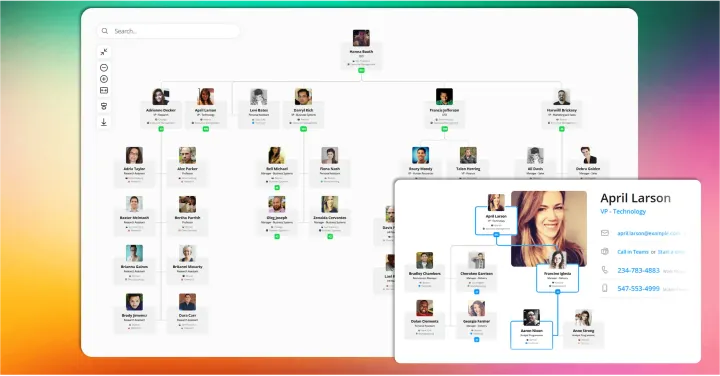Everything A Leader Should Know About Cross-Functional Teams
Here's everything you need to know about creating and managing cross-functional teams. Learn the benefits of breaking down silos, best practices for setting goals and expectations, and tips for maximizing innovation.

Have you ever felt like your team is stuck in a rut, spinning their wheels without making real progress? Or maybe you've found yourself butting heads with other departments, each pursuing their own goals without coordination? If so, you're not alone.
In today's complex business world, it's all too easy for organizations to become siloed and uncreative. But what if there was a way to break down those barriers and tap into the collective wisdom of your entire workforce?
That's where cross-functional teams come in. By bringing together diverse perspectives and expertise, these dynamic groups can supercharge innovation, efficiency, and strategic alignment.
Here's what you need to know about cross-functional teams:
What Are Cross-Functional Teams?
A cross-functional team is a group of employees from different departments working together on a project. Each will bring their skills, perspective, and expertise, typically from their regular departmental work.
Think of a cross-functional team as a multitalented orchestra, with each member contributing their unique skills and knowledge to create a harmonious masterpiece. Instead of being confined to a single department or function, these teams draw employees from various areas of the organization to tackle complex, multifaceted projects.
For example, when developing a new product, a cross-functional team might include engineers for the technical aspects, marketers to understand customer needs, finance experts to analyze costs and revenue potential, and operations personnel to plan for manufacturing and distribution. By combining their diverse viewpoints from the get-go, the team can identify potential roadblocks early and develop more holistic solutions.
The Main Advantages of Cross-Functional Teams
Here are just a few of the major benefits that cross-functional teams can unlock:
- Innovation Unleashed: When you bring together people with diverse backgrounds and ways of thinking, the sparks of creativity are bound to fly. Fresh perspectives challenge assumptions and inspire novel solutions.
- Efficiency Boosted: With all the key stakeholders in the room from the start, issues can be identified and addressed early on, avoiding the endless back-and-forth that plagues siloed departments.
- Strategic Alignment: Cross-functional teams are perfectly positioned to keep their initiatives aligned with the organization's overarching goals, rather than pursuing isolated departmental agendas.
- Status Quo Disrupted: Groupthink and resistance to change often fester in insular silos. Cross-functional teams provide a healthy dose of disruption, questioning long-held beliefs and fostering a culture of continuous improvement.
The Challenges of Cross-Functional Teams
Cross-functional teams, while rich in potential for innovation and problem-solving, face a series of distinct challenges that can impede their success. The unique structure of these teams often brings complex interpersonal and operational issues to the forefront. Here is a detailed exploration of the difficulties encountered:
- Conflicting Priorities: With team members juggling responsibilities to their home departments and the cross-functional initiative, competing priorities can breed tension and inefficiency.
- Authority Ambiguity: Unclear leadership and decision-making protocols can lead to gridlock, as the team gets mired in endless approval-seeking from various department heads.
- Resource Constraints: Department leaders may be hesitant to allocate their top talent and budgets to cross-functional projects, fearing it could detract from their core objectives.
- Accountability Dilution: In a collective decision-making environment, individual accountability can become blurred, with team members passing the buck when issues arise.
- Cultural Inertia: Deeply entrenched silos can foster an "us versus them" mentality that impedes collaboration and mutual understanding.
- Lack of Strong Leadership: Cross-functional teams need a skilled leader who can set a clear vision, manage conflicts, and advocate for the team's needs across the organization.
- Poor Planning: Ambiguous project plans and timelines breed misaligned expectations and confusion among team members.
Addressing these challenges requires a proactive approach, including the development of clear communication channels, alignment of goals across departments, and strong leadership to guide the team. By acknowledging and strategically managing these hurdles, cross-functional teams can leverage their diverse strengths and achieve their collective goals.
When Is the Right Time to Create a Cross-Functional Team?
Understanding the optimal timing for assembling a cross-functional team is key to leveraging the diverse expertise needed for complex projects. Such teams are particularly effective when a project's scope extends across various disciplines, necessitating a rich blend of skills and viewpoints.
Key Indicators for Forming a Cross-Functional Team:
- Project Complexity: If the project involves complicated tasks that benefit from varied specialties, this signals the need for a cross-functional approach.
- Need for Innovation: When innovation is a critical component of the project's success, bringing together diverse perspectives can spark creativity and novel solutions.
- Interdepartmental Impact: Projects that affect multiple departments or require inputs from them to succeed are ideal candidates for cross-functional teams.
Cross-functional teams bridge the gap between varied organizational areas, fostering a collaborative environment that can significantly enhance the execution and success of ambitious projects. Assembling such teams at the right moment is crucial for tapping into the collective intelligence and capabilities of different departments.
Practical Applications of Cross-Functional Teams
In practice, cross-functional teams are especially effective in complex, high-impact projects. For instance, consider a multi-year advertising campaign aimed at boosting brand awareness, attracting new customers, and achieving ambitious revenue goals. Such a project would benefit immensely from the diverse expertise of members from sales, revenue, and demand generation, alongside the marketing team.
Additionally, projects using the Agile methodology are ideal for cross-functional teams due to their collaborative nature. For example, when updating a new software product, assembling a team that includes software engineers, product marketers, and content designers who all practice Agile can lead to more innovative and responsive project outcomes.
By combining structured planning with strategic team composition, cross-functional teams can transform ambitious projects from mere concepts into successful, tangible results.
How to Make Sure Your Cross-Functional Teams Are Effective?
While the concept of cross-functional teams sounds appealing, making them truly effective requires careful orchestration. Like a well-oiled machine, several key elements must work in sync:
- Clear Objectives: These teams can't simply wing it. They need clearly defined goals that tie directly to the organization's strategic objectives. This shared purpose provides a rallying point and ensures everyone is moving in the same direction.
- Structured Plans: A high-level project plan with milestones and deadlines keeps the team focused and accountable. It's like a roadmap that guides their journey from start to finish.
- Team Identity: Fostering a "one team" mentality is crucial. Activities like off-site retreats and social events help break down silos and build strong interpersonal bonds. After all, a house divided against itself cannot stand.
- Defined Roles: While diversity is an asset, chaos ensues without clear roles and decision-making protocols. Spelling out who has authority over what decisions creates a sense of order and prevents endless deliberations.
- Open Communication: Cross-functional teams must embrace open and honest dialogue, even (or especially) when discussing sensitive or controversial topics. Establishing norms that encourage respectful debate and dissenting opinions is key.
- Productive Conflict: Speaking of debate, a little constructive conflict can be a good thing. It challenges groupthink and spurs creativity. The key is teaching the team how to argue ideas, not people, and making it a safe space for differing perspectives.
- Transparency: No secrets allowed! Cross-functional teams thrive on transparency, with all relevant information shared openly among members. This fosters trust and ensures everyone is operating with the same understanding.
Understanding the Differences: Functional vs. Cross-Functional Teams
What’s a Functional Team?
A functional team is structured around a specific area of knowledge or expertise. Members of a functional team typically have similar skills, roles, and responsibilities, which enables them to focus deeply on specific tasks. This concentration helps streamline processes within their area but can limit their perspective to just that one aspect of the organization.
What’s a Cross-Functional Team?
Conversely, a cross-functional team is diverse, consisting of members from various departments and backgrounds. This variety allows for a broader range of ideas and skills to converge, fostering innovative solutions and faster problem-solving. Such teams are designed to tackle larger organizational objectives that benefit from multiple areas of expertise.
Key Differences
- Composition: Functional teams are homogeneous, while cross-functional teams are heterogeneous.
- Purpose: Functional teams excel in targeted, specialized tasks within their realm. In contrast, cross-functional teams address complex projects that require input from multiple disciplines.
- Outcome: While functional teams enhance efficiency within a specific department, cross-functional teams drive innovation and accelerate the execution of broader business strategies.
These distinctions underscore the importance of choosing the right team structure based on the goals and challenges at hand.
The Path to Cross-Functional Mastery
Many of the world's most innovative companies like Apple, Google, and Amazon have made cross-functional collaboration a core part of their DNA. They understand that the magic happens when you empower diverse talent to join forces and tackle audacious challenges together.
So, if you find yourself facing a complex, multifaceted challenge that transcends the boundaries of any single department, don't go it alone. Assemble a cross-functional dream team, and watch as the collective intelligence of your organization propels you toward success.
After all, as the old adage reminds us, "If you want to go fast, go alone. If you want to go far, go together."


